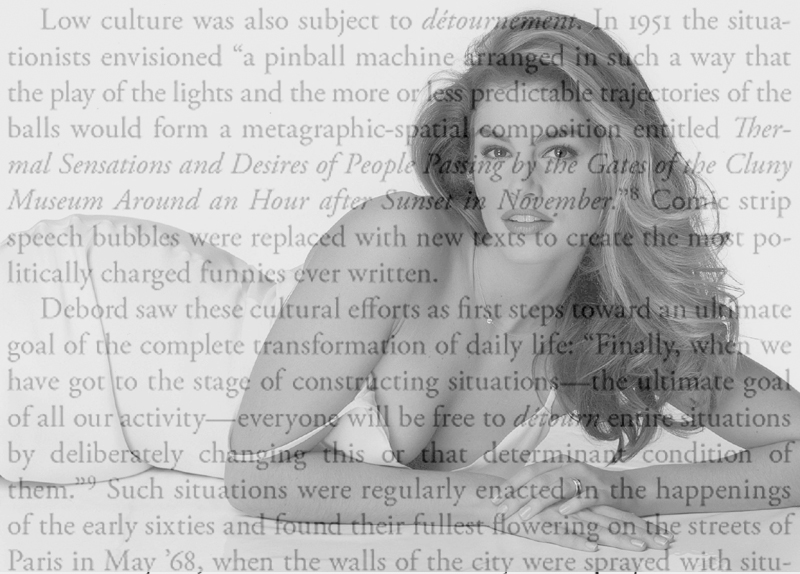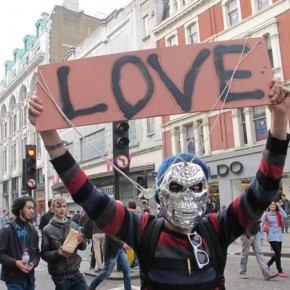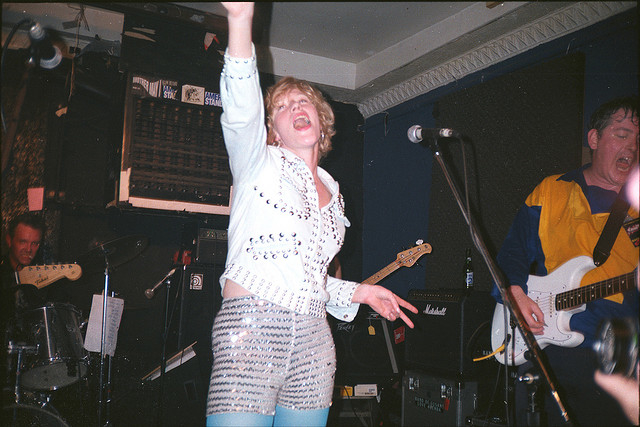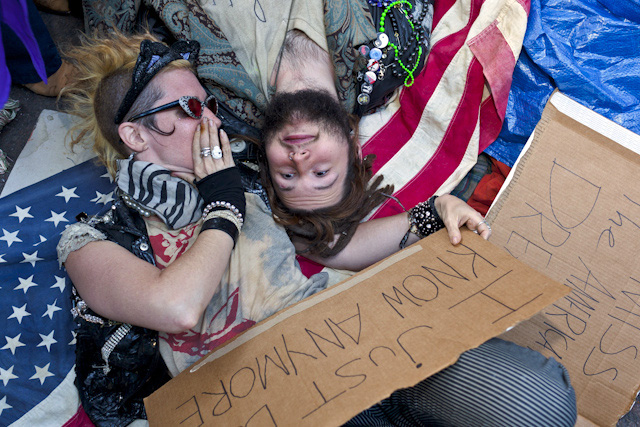On November 4th, Harriet, the Poetry Foundation’s blog, published a photo of Cindy Crawford reading Uncreative Writing, Kenneth Goldsmith’s new essay collection. There’s no attempt to explain why a former supermodel and current home furnishings magnate would spend her time reading a book of essays about avant-garde poetics, and it seems unlikely that a woman so attuned to the value of her own image would pose so readily for what amounts to a promotional photo. On the other hand, if Crawford really did spend a crisp autumn afternoon reading a book about avant-garde poetics, there’s clearly a lot I don’t understand about her.
Whether it’s a Photoshop job or not, there’s something appropriate about the owner of one of the most reproduced faces of the 1990s reading Uncreative Writing. Goldsmith is the poetry world’s equivalent of a star, and the reasons behind his stardom have as much to do with the valorization of surface and spectacle as the success of any model does. Whereas the librarian of the U.S. Congress continues to appoint sturdy éminence grises (W.S. Merwin) or placid miniaturists (Billy Collins) as Poet Laureate, the lack of glamour and vitality in these selections has virtually assured that the first time most Americans hear the name of The Most Prominent Poet In The U.S. will also be the last. Whether or not his work can even be compared to that of writers still working with the lyric — to say nothing of those who truck with the villanelle, the sestina, and the good old sonnet — Goldsmith, who dresses like an art-school dandy and spiels like Professor P.T. Barnum, has certainly got it over them in the glamour department.
And while he’s probably not on anyone’s short list for Poet Laureate, Goldsmith did make it to the White House earlier this year for the Obamas’ “Celebration of American Poetry.” There he read alongside a number of other more traditional versifiers like Collins, Rita Dove, and Elizabeth Alexander, and dressed like an insane person. There was a quasi-controversy stirred up in the right wing media surrounding the appearance of the rapper Common, but any remaining tweeded-and-bowtied Allan Bloom-conservative types may have taken more issue with Goldsmith’s presence which was, in an interesting, complicated, and healthy way, a paisley-clad insult to poetry as it’s generally understood.
Goldsmith, who also founded and runs UbuWeb, made his reputation in the poetry world with tomes like No. 111 (1997), in which he alphabetizes and arranges by number of syllables thousands of words and phrases that end in the “r” sound, and Soliloquy (2001), in which he records and transcribes every sound he made for a week. In Day (2003) he transcribes an entire issue of the New York Times, including advertisements and stock prices and in his American Trilogy (Traffic, The Weather, and Sports), he transcribes radio broadcasts.
His work has consistently revolved around practices generally relegated to the Bartlebyan category of writing-as-manual-labor, but which have, at least since Marcel Duchamp’s readymades, been a part of mainstream art practice for around a century. When Goldsmith advocates that poets transcribe television shows or copy out the work of other poets line for line, he means exactly what he says. Soliloquy itself is a model of transcription at work — every “um,” “uh,” stutter, sneeze, and half-finished phrase that passes through Goldsmith’s lips makes it onto the page.
In lectures, on panels, at readings, in the poetry workshops he teaches at the University of Pennsylvania, and now in the essays collected in Uncreative Writing, Goldsmith has been attempting to revitalize what he sees as a stagnant writing culture. “Literature,” he writes in the introduction to that book, “is in a rut, tending to hit the same note again and again, confining itself to the narrowest of spectrums, resulting in a practice that has fallen out of step and unable to take part in arguably the most vital and exciting cultural discourse of our time.” One of the roots of this malaise, as he sees it, is in a too-narrow definition of creativity, one that prizes well-crafted prose and the overt expression of thoughts and feelings. Rather than the expressive, Goldsmith prizes what he calls “conceptual poetics,” poetic gestures made in the vein of the conceptual art of Andy Warhol, Lawrence Weiner, and Sol LeWitt. He prefers to think of himself as possessing a “thinkership” rather than a “readership,” as he gleefully claims that it’s not necessary to actually read his work—knowing the general concept is enough.
It’s easy to see why a claim like this could be unsettling for people interested in poetry. Poetry, after all, is made out of language. To claim that you don’t have to read a book of poems in order to understand it is to marginalize language, to do away with the sensuous substance out of which poetry is supposedly cobbled. But for Goldsmith, a commitment to language as a medium dependent on “expression” forecloses all of the interesting linguistic possibilities the digital age has made available to poets. Counterintuitively, the most rote poetic procedures make for the most radical poetic possibilities. For instance, Goldsmith imagines that the techniques of uncreative writing enable a new mode of poetic political critique: “If we wished to critique globalism, for example, uncreative writing’s response would be to replicate and reframe the transcript from a G8 summit meeting where they refused to ratify climate control threats as is, revealing much more than one ever could by editorializing. Let the text speak for itself: in the case of the G8, they’ll hang themselves through their own stupidity. I call this poetry.”
And yet what Goldsmith calls poetry is also, after WikiLeaks, what The New York Times calls journalism. More and more, the presentation of unedited, found, and recontextualized media is usurping the role played by traditional outlets. In a way, conceptual poetics is poetry’s answer to these cultural and technological changes. If the rise of citizen journalism suggests that anyone could be a journalist, conceptual poetics suggests that any text could be a poem. The proliferation of cell phone cameras makes it more and more likely that any event, whether an act of kindness or an atrocity, will become news and will take on a life beyond its original context. If any text can be a poem, then, it is not because it is written in iambic pentameter or contains particularly beautiful language; rather, the act of contextualizing, of framing, of re-presenting makes it so.
So then what prevents the recontextualized G8 transcript from being just a G8 transcript? The answer is, strangely enough, that the transcript itself expresses nothing in particular (except for the opinions of the participants in the summit), while the use of transcript as poetry itself serves as a form of expression. As Goldsmith sees it, “The suppression of self-expression is impossible. Even when we do something as seemingly ‘uncreative’ as retyping a few pages, we express ourselves in a variety of ways.” With conceptual poetics, expression comes by way of making choices of presentation rather than by writing phrases whose content expresses something. When Goldsmith polemicizes “against expression” (the name of an an anthology of conceptual poetry he co-edited with the poet-critic Craig Dworkin), he means writing that is written explicitly in order to express thoughts and feelings.
There’s certainly a democratic impulse in Goldsmith’s work, one that perhaps claims too much. By making the move from expressive writing to expressive context, from readership to thinkership, Goldsmith writes that “We can begin to think of uncreative writing as having the potential to be a body of literature able to be understood by anyone. If you get the concept (and the concepts are simple) — regardless of your geographic location, income level, education, or social status — you can engage with this writing. It’s open to all.” If any text can become poetry, if the qualifications for the job of “poet” no longer even necessarily include an ability to write well, if the interpretation of poetry no longer requires careful attention to language but only “the concept,” anyone can be a poet and poetry can be understood by everyone. These are all big ifs. The universality Goldsmith envisions for conceptual poetics seems to want to downplay the contingencies that make the creativity of uncreative writing legible, that makes us understand the G8 transcript as poetry rather than a transcript. How many assumptions must we share in order to read the G8 transcript as a critique? Enough to make the critique itself unnecessary. In other words, the degree to which it’s an interesting poetic project depends on the degree to which we can consign the actual content of the transcript to the realm of absurd malevolence without qualms.
Unfortunately there are people who think otherwise, people who would not only take the G8 transcript for what it is, but agree with its conclusions. That’s the problem with universality: it includes even those people who are evil sons of bitches and must be stopped. Goldsmith’s project, as fascinating and productive and innovative as it is, has more than a touch of the utopian about it. It’s a flavor of utopianism that equates technological progress with political progress, poetic innovation with human freedom. It’s true that staid conceptions of “creativity” have shackled writers for too long, that writers have had to forgo the pleasures and risks enjoyed by their peers in the art world. In that sense, Goldsmith’s project is liberating. His talents as a promoter of his own work and those of his fellow travelers can only be a good thing for the existence of poetry outside of the narrow boundaries drawn for it in American cultural life. But to assume that poetic innovation, like the internet or social networking or democracy, comes with progressive politics built into it is something like assuming the Crawford photo is a fake. By assuming it is, by nullifying its content and seeing it as a conceptual play on image, glamor, and fame, we lose its weirdness and the possibility that it might have something to say.






I find the lead for this is offensive. You repeat all of the problems of the fashion industry — objectification and sex-selling. Do you remember that you are talking about a woman? A specific woman — who eats breakfast and uses a pencil. Also women in a larger sense. Just because the industry — and her living — made her into an flattened, idealized, symbol-image for objectification doesn’t mean you should. I imagine a caption next to this image “I am not your simple-minded sex goddess, I just play one on TV for your superiority complex’s enjoyment.” I think you’ve also insulted poetry with it.
Jennifer, the image — for which I, the editor, not the author am responsible — was intended to be a commentary on the way in which Cindy Crawford’s image is used in the photograph described in the piece. Maybe it didn’t come off as well as it could have, but the whole point was to question the impetus to use her in that way. That’s why the text is derived from Kenneth Goldsmith’s book. Anyway, my sincere apologies for having offended you (and anyone else).
I was talking about the writing — but thanks for the thinking!
Jennifer, I certainly agree that the use of Crawford to promote the book, whether through a staged shot or a Photoshopped image, is problematic.
No, no: the problem is in Mr. Sussman’s writing here, not in “the use of Crawford to promote the book,” which we’re still unclear about. The first paragraph of this piece is a treasure trove of symptomatically sexist assumptions – without solid facts about the origin or intended destination of the photograph, without actually hearing from Ms. Crawford herself, it’s just stupid to assume anything about the woman in it. Perhaps Cindy Crawford has long been interested in contemporary poetry, perhaps a friend of a friend is a big fan of Goldsmith’s work, perhaps she just found the title intriguing and, like so many readers, picked up the book not knowing what it held in store for her.
I think what Mark is pointing to here is the surreal and unusual crashing of worlds that are almost never in the same room together: mainstream culture and the avant-garde. The image could’ve been of, say, Obama, or Jay-Z or Thomas Friedman reading such a book and it would be equally strange and worth noting. He used Cindy Crawford because she was the one photographed reading it.
Traditional poetix : painting :: Goldsmith’s poetix : photography
No-brainer?
First, I loved this piece. Second:
Cindy Crawford in Wikipedia: “Crawford graduated from DeKalb High School in 1984, as valedictorian.[5] She won an academic scholarship to study chemical engineering at Northwestern University, which she attended for only one quarter. She dropped out in order to pursue a full-time modeling career.”
Why is it so hard for people to look this up? She has brains beyond the face.
A link to the image in question:
http://www.poetryfoundation.org/harriet/2011/11/cindy-crawford-reads-kenny-goldsmiths-uncreative-writing/